Victoria Manganiello of Lady Art: NYC by Quinne Myers
March 8, 2017
Our final spotlight on Lady Art Writers and Artists comes from New York-based Quinne Myers writing about dyer, weaver, and spinner Victoria Manganiello. It is so wonderful to be able to do a series of features on some amazing makers across the country, all approaching textiles with different backgrounds, techniques, concepts, and intentions.
Textile artist Victoria Manganiello weaves hand-dyed yarns of varying fibers to create paintings—bridging the hyper-modern New York City fine art world and the quietly-traditional textile world. Much of Victoria’s work is about creating and finding bridges—between people, between art forms, between the past and present.
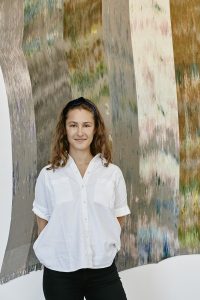
Victoria Manganiello
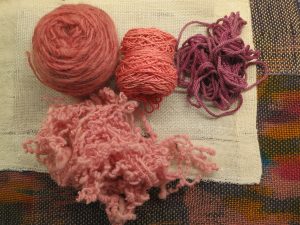
Various spun fibers in Victoria’s studio, all dyed using cochineal. Photo: Quinne Myers.
Victoria’s pieces often start with pure, un-spun fiber, which she dyes and spins herself. The weaving itself is a lot of trial-and-error; instead of planning a large piece, she’ll move through the process of weaving as if it’s meditation, creating what feels right at the time, placing dye or chemically removing color as the bobbin goes back and forth through the loom. Later, she slices and reorganizes pieces of the new fabric to create harmonious compositions.
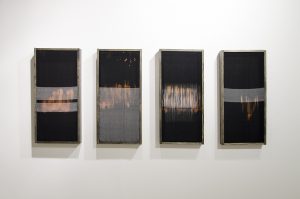
Victoria Manganiello Lucent Trans 2015, cotton, ilk, natural and synthetic dye (hand dyed and woven, framed in artist made frames), series of 4: 35″ x 17″ each. Photo by Artist.
It might take more time or emotional energy to create a weaving than a painting, but the painting will often be assigned a higher value, perhaps because textile creation is historically considered “women’s work.” By presenting the textiles as stretched canvas, an act typically utilized as the first step rather than the last step of creating a painting, Victoria bridges the gap between “craft” and “fine art” and allows the viewer to reexamine how careful and precious fabric can be.
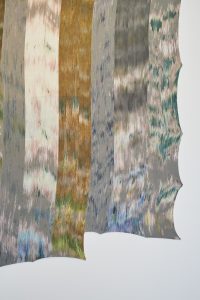
Victoria Manganiello Untitled #50 2016, cotton, natural and synthetic dye (hand dyed and woven, installed directly onto the wall, varies upon re-installation), 117″ x 86″. Photo: Kate Reeder.
She moves between the idea of stretching her work to become a canvas, to creating a canvas to fit the work. The unique properties of the various fibers woven together create non-uniform edges on each of her weavings. Instead of forcing those shapes into a perfectly rectangular presentation, Victoria sometimes showcases her work in a way that highlights the uneven edges.
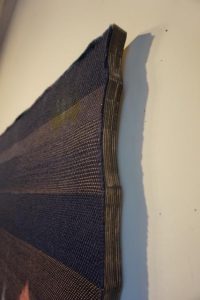
A carved wooden platform mimics the exact organic edges of this particular piece. Photo by Artist.
She displays them on the wall exactly as they are without stretching or folding, or on wooden platforms that are custom-carved for each piece, lending depth and showcasing those organic lines.
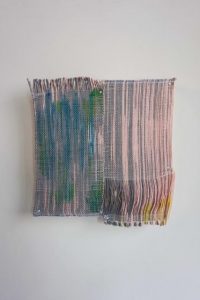
Victoria Manganiello Untitled #16 2016, cotton, natural and synthetic dye (hand dyed, spun, woven, atop custom platform which matches natural selvedges of canvas), 8.5″ x 9″. Photo by Artist.
There’s a beautiful play between textile and canvas in Victoria’s work, whether the textile is pulled and mounted over mathematically-perfect wood, or the wood is carved precisely to match the textile.
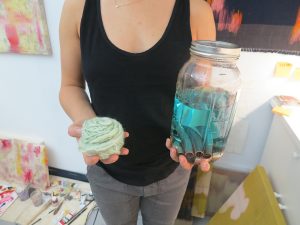
Copper-dyed yarn, and a jar of copper dye being prepared. Photo: Quinne Myers.
Nearly every color can be created with natural dyes, and Victoria’s work thrives on this idea. She creates many of her dyes from scratch, using onion skins from her kitchen or dried herbs from local suppliers. Neon celery green is created from a mix of turmeric and indigo; a perfectly pale mint hue, from copper pipes soaking in water; various shades of pink, red, salmon, and magenta all come from cochineal. Synthetics are used alongside natural dyes in some pieces, but Victoria says this can make them feel less than harmonious.
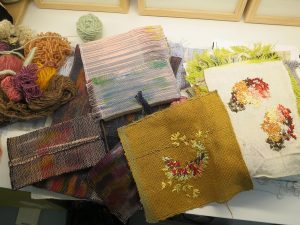
Some of Victoria’s work in her studio. Photo: Quinne Myers.
The concepts of non-linear time and the interconnectedness of humanity play large parts in her work. Weaving itself, she says, is like any individual’s life; just like a woven textile that takes so many moments to create and places those moments on display, all parts of your experience, past and present, exist simultaneously within you.
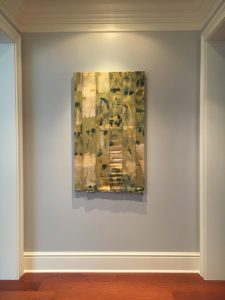
Victoria Manganiello Mantis 2015, cotton, natural and synthetic dye, (hand dyed and woven, stretch), 45″ x 23″. Photo by Artist.
She’s enthralled by the idea that every human on the planet intimately interacts with some form of textile every day, and believes that as a species, we are deeply connected to fiber. Victoria assumes this draws so many viewers of her work to reach out and feel it–even at fine art galleries, where touching pieces on display is instinctively taboo.
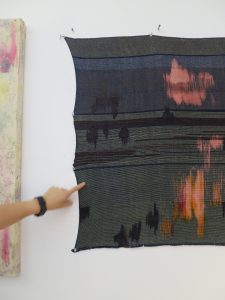
A new piece on the wall of Victoria’s studio. Photo: Quinne Myers.
Her work with fiber also inherently makes abstract art more accessible. She explains that an abstract painting can feel alienating and confusing to an individual without an art background, but when the medium is something that person interacts with every day, the piece becomes instantly relatable.
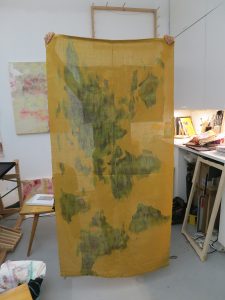
A clearly map-inspired piece, made from two separate pieces of fabric engineered to match perfect. Photo: Quinne Myers.
Victoria’s background in art education explains why humanity, empathy, and connection are so clearly present in her work. “Being able to make something is what makes us human in a very pure way,” she says. “It’s a thrill to be reminded that I’m human.”
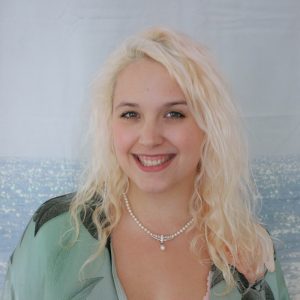
Quinne Myers is a Brooklyn-based multi-passionate individual with an inherent love of textile and surface design.

1 Comment
Albert B Ayala says
March 21, 2017 at 2:18 pm
I like what you guys tend to be up too. Such clever work and reporting! Keep up the terrific works guys I've incorporated you guys to my blogroll.
Related Blog Articles
collective
“FEMAIL: AMPM (2.0) Review” by Lauren Sinner
collective
Spotlight: Lady Art NYC with Olivia Jane